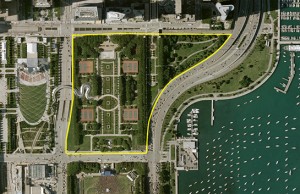
New walking spaces and recreation are coming to the Chicago Loop and lakefront with the redesigned Maggie Daley Park. The Park District will be opening some attractions as early as December, while others we can look forward to enjoying when the Spring and nice weather return. Even better news for fans of the Pedway (Chicago Detours is): The project will help expand the Pedway’s reach through the lakeshore, too. Let’s get ready to welcome the new Maggie Daley Park – a project so much more complicated than simply one level of parkland – to the Chicago Lakefront.
Maggie Daley Park History
The soon-to-be Maggie Daley Park is on the north end Grant Park, just east of Columbus Drive and Millenium Park and backing up to Lakeshore Drive. This was just lake water here back in 1836 when when the first decision was made to keep the lakeshore “forever open, clear, and free” of buildings and businesses. After the fire of 1871, debris from the charred downtown was piled between the shoreline and the railroad causeway, gradually expanding the park to the east.
In the late 1880’s, Aaron Montgomery Ward began his campaign to save the lakefront: known in his lifetime as the “watchdog of the lakefront,” Ward sued the city twice to keep buildings off park grounds. The legal battle that pitched the catalog-millionaire against the department-store-millionaire, Ward succeeded in forcing the Field Museum (so called for its chief donor, Marshall Fields) to relocate south of the park. In the early 1900s, addition of more landfill grew the park further.
In 1976 a parking lot on the current site of Maggie Daley Park was torn apart and rebuilt underground. They also added a Field House and renamed it Daley Bicentennial Plaza. Now it dons the name of the wife of Mayor Richard M. Daley, known for her charity work, who died in 2011 after a 9-year-battle with cancer.

Down Below Maggie Daley Park
Secrets lie underneath this area of North Grant Park. Not least is the East Monroe Street Parking Garage, which has been aching for renovations for years. It is part of a complex of four parking garages under Millennium Park and North Grant Park, and it’s the biggest piece of the biggest underground parking system in the United States. It’s well hidden in the park by Frank Gehry’s first and only bridge design, the beautiful BP Pedestrian Bridge. Next time you walk this bridge, look out for the cluster of white ash, elm, and sycamore trees. Next to it are grates resting at the top of a hill. Those grates provide air to garage underneath, and what you thought was a hill is a covering over 4,000 parked cars.
Also tucked under the visible Park area? Access to the McDonald’s Cycle Center, where you can lock your bike, take a shower, leave your clothes in a locker, and enjoy the Loop even after a lengthy bike ride into it. Everything from the Harris Theater to the the residential areas by Aqua will be linked by the Pedway.
Also below the surface: portions of the new Field House: a modern design whose visible elements will be glass and clean white lines, replacing the old brutalist brick structure.
The completion of this park project will hopefully improve the functionality of all these pieces, and make the area more attractive to commuters and tourists – no matter what the weather throws at us!
Just Below the Grass of Maggie Daley Park
One more level of this layer cake needs to be mentioned before we even get to the park itself: the geofoam providing light-weight topography for the park’s soon-to-be-winding paths. Since the park itself is like a giant green roof over the parking garage, keeping the overall structure light in weight is a requirement. And geofoam is strong and provides the possibility of creating interesting shapes and contours.

Street Level of Maggie Daley Park
Besides the bright, modern new Maggie Daley Field House, a rock-climbing wall, viewing platforms, thousands of trees, and a skate park, the new parkland will boast an ice skating rink during the winter. I will meander through pine trees like a man-made frozen river. Crews have been finishing some of the landscaping and lighting that will work in tandem to create a more wild, natural look. (A wild natural look supplemented with views of skyscrapers, the climbing wall, and the lake, of course.)
Almost 900 trees were removed from the park space, both to allow for construction and because without a diversity of species, many were getting sick or damaged. They will be replaced by thousands of plantings of a wider variety. A few will come back, as benches or as fill for the children’s playground which will open in 2015. And it’s due to open …..
Lights meant to replicate moonlight surround Maggie Daley Park. Once the landscaping has matured, plants and branches will hide their white poles so that they appear as floating orbs.
The project is described, pictures and updates provided, and even more information can be found with the Chicago Park District.
If you’d like to learn more about the park, we visit it as an example of super new architecture on our Chicago Architecture History Crash Course Tour.
–Vicki Rector, Tour Guide












